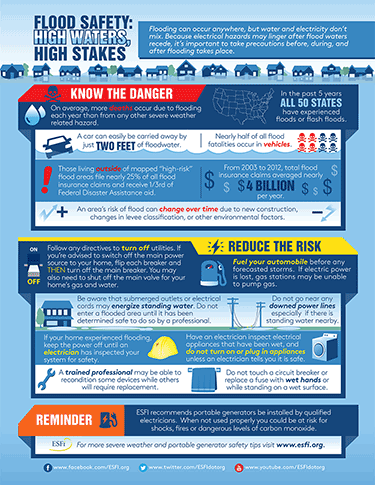Electrical Safety Resources
Electrical safety during natural disasters to be the educational focus for the Electrical Safety Foundation International.
May is National Electrical Safety Month, and the Electrical Safety Foundation International (ESFI) reminds us that disasters bring serious risks for electricity-related fatalities, injuries and property loss. To highlight those risks and ways to plan for severe weather events, this year’s campaign theme is “Electrical Safety During Disasters.”
“As families begin to clean up following a storm or flood, we want them to be mindful of the potential dangers that exist whenever water comes into contact with electricity,” cautions ESFI President Brett Brenner. “Before flipping a switch or plugging in an appliance, have a qualified electrician check the house wiring and appliances to make sure they are safe to use.”
Electrical safety precautions
Following are some electrical safety tips from ESFI experts to keep in mind during and after severe storms and other natural disasters:
Prepare for the storm
- Charge all phone and communications devices.
- Move computers and other electronic devices to countertops or tables to avoid water damage from flooding.
- Turn off circuit breakers to avoid power surges.
- If you plan to use a portable generator during the storm, ensure that a qualified electrician has installed it and make sure to use a listed and approved transfer switch and ground fault circuit interrupter (GFCI) protection.
Weather the storm
- Stay indoors during hurricanes and away from windows and glass.
- Never operate a portable generator inside your home or garage.
- Do not connect generators directly to the household wiring unless an appropriate transfer switch has been installed by a licensed, qualified electrician.
- Always use GFCIs in areas where water and electricity may come in contact. The National Electrical Code® (NEC) currently requires that GFCIs be installed in all kitchens, bathrooms, garages, outdoors and within 6 feet of any sink.
Recover from the storm
- Have a qualified electrician inspect any water-damaged electrical equipment and electronics. Electrical items, such as circuit breakers, fuses, GFCIs, receptacles, plugs and switches, can malfunction when water and silt get inside. Discard them if they have been submerged.
- If flooding has occurred, have a qualified electrician inspect your electrical system.
- Do not touch a circuit breaker or replace a fuse with wet hands or while standing on a wet surface.
- Report and stay away from downed power lines and always assume they are energized. Never touch a person or object that is in direct or indirect contact with a downed power line, such as a fence, tree limb or water. Instead, call 911 immediately.
- Avoid flooded areas as they may be electrified. Even nonconductive materials like wood or cloth that are slightly wet can conduct electricity.
- If you smell gas, notify emergency authorities immediately. Do not turn on lights, light matches or engage in any activity that could create a spark.
Online electrical safety resources
ESFI offers additional safety training materials. An infographic, titled “Flood Safety: High Waters, High Stakes,” outlines precautions to take before, during, and after flooding during a storm. An educational video, Consumer Electrical Safety During Disasters, is available in both English and Spanish languages.
“There are many hazards during a storm, which is why it’s important to treat electricity with extreme caution during these events,” explains Brenner. “Don’t let your home become a statistic. Practice periodic home electrical safety inspections and call in an electrician to address any problems you may uncover.”
ESFI’s National Electrical Safety Month campaign features a comprehensive collection of new and updated electrical safety awareness resources. These include useful videos, fact sheets and related safety tips. For ESFI’s complete collection of National Electrical Safety Month resources and for information on using them in your community, visit www.ESFI.org/nesm.
Editor’s note: This article is from ESFI.
























